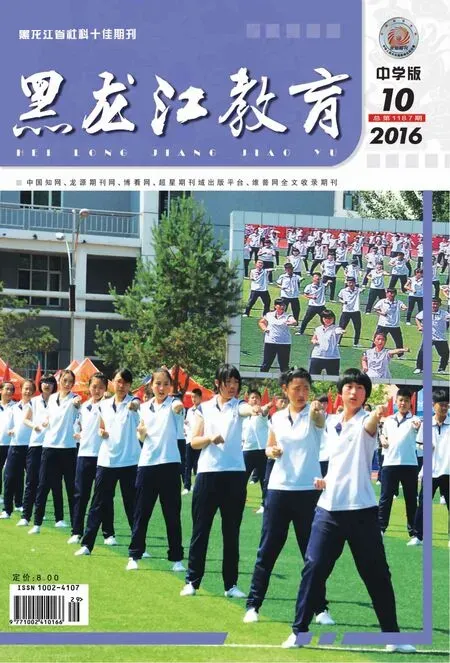Starter Unit 2 What's this in English?教学设计及说明
执教者:牡丹江市实验中学 刘欢欢 指导者:牡丹江市教育教学研究院 张丽华
Starter Unit 2 What's this in English?教学设计及说明
执教者:牡丹江市实验中学刘欢欢指导者:牡丹江市教育教学研究院张丽华
一、教学内容与分析
本课选自新目标英语七年级上Starter Unit2,是其中的预备单元。预备篇是为了使没有英语学习基础的学生更好地使用本套教材而编写的。它的主要内容为26个英文字母和最基本的英语日常用语。本单元的教学内容为:Ii—Rr10个字母;ruler,map,quilt,jacket,key等7个单词;辨认物品Whatis this/that in English?及其回答。学生在实践中学会和使用目标语,同时借助“任务型”教学,通过听、说、写、练等一系列教学活动,充分利用图片、实物、卡片等辅助教学,创设更多、更完善的情景,为学生提供更多真实的语言实践机会。同时在小组活动中培养学生的合作意识和团队竞争意识。
二、教学目标
1.语言知识目标:
①复习字母Aa-Hh;②学习并掌握字母Ii-Rr;③学习一些日常用品的单词;④学习如何识别事物。
2.语言技能目标:
①学会在单词中识别所学字母;②学会询问和识别周围事物的名称;③学会用简单的日常用语与人交流。
3.情感态度与价值观:通过完成各种教学任务,培养学生对事物的辨别能力。
三、教学重、难点
重点:①学会并掌握字母Ii-Rr及map,orange,jacket,key,pen,ruler等单词;②学习并掌握what引导的特殊疑问句。
难点:灵活运用所学字母,在识别事物的过程中培养学生的辨别能力。
四、教学步骤
Step IGreeting
T:Classbegins!Goodmorning,boysand girls.
S:Goodmorning,teacher.
T:How are you?
S:I'm fine,thanks.
T:I'm fine,too.Sitdown,please.
Step IIReview the letters A-H
①Read the letters
T:In the lastunit,we have learnt the letters from A to H.Now let's read the letters together.
设计说明:学生用升降调齐读字母A-H,复习之前所学的字母的读音。
②Write the letters
T:Now,open your books.Turn to Page...Look at the picture in 1a.Try to find out the small letters for A-H and write thesmall lettersnext to thebig letterson your book.
(Ask one student to w rite the letters on the blackboard.)
(Textbook Starter P5 1a)
T:Let'scheck the answers together.
(The students say the answers and the teacher checks the letterson the blackboard.)
设计说明:完成课本1a的任务,找出A-H对应的小写字母,复习前一单元所学的字母。
Step IIINew letters
①Present the New letters I-R
T:Look at the picture again.Do you know the namesof other letters?Who can try?
(Some studentstry to name them.)S1:J,L. S2:I.
T:Verygood.This is“I”.Read afterme,“I”.
Ss:“I”.
(Show the lettercardsand teach the lettersoneby one.)
(W rite the letter“Ii”on the blackboard.Teach how to w rite big letter and small letter.The students read and w rite. Then teach the other letters“Jj,Kk,Ll,Mm,Nn,Oo,Pp,Qq,R r”in the sameway.)
设计说明:利用书上的图片创设语言情境,引入新字母的学习。教授新字母的读音、大小写的区别及书写时占格情况。
②Practice the letters.
T:The letters are not arranged alphabetically.Please put them in order.
(Ask one student to come to the blackboard to put the letters in order,the othersdo thisw ith the partner.)
(Give the students letter cardsbefore class.)
设计说明:通过打乱字母卡片的顺序,让学生按字母表顺序排序,在游戏中巩固所学字母。
Step IV New words
①Present thenew words.
T:My good friend Helen has a big room.And this is a pictureofher room.
(Draw a picture of a room w ith the thingsaround us on the blackboard before class.)
T:There are many things in it.Today I bring some thingshere.
T:What's this in English?
(Hold a pen.)
Ss:Itisapen.
T:Yes,it'sa pen.Read afterme,P-E-N,pen.
Ss:P-E-N,pen.
T:This is an orange.Read afterme,O-R-A-N-G-E,orange.
Ss:O-R-A-N-G-E,orange.
T:Orange,the first letter is“O”.It's an orange.
(Teach the other words“map,key,jacket,ru ler,cup,quilt”in the sameway.)
设计说明:利用黑板上的房间图片创设情境,引出新单词的学习并利用实物教授单词。
②Practice thenew words.
(1)Read thewords
T:Read the new wordsafterme.Map.
Ss:Map,map,map.
(2)Task One:Match the pictureswith thewords
T:Now takeout the picturesand theword list.Work in groupsof four.Put thepicturenext to theword.
T:Who can helpme to finish iton the blackboard?
(Students put the pictures next to the words by working in agroup.W hen they finish,they putup the paper on the blackboard.Ask one student to come to the blackboard to do it.)
(Give the studentssome picturesand aword list before class.)
设计说明:在任务中练习单词。任务一:学生把图片贴在单词旁边,图文并茂地帮助学生记忆,同时小组合作的形式,既让人人都参与,又消除了独立完成的紧张感。
(3)Task Two:Write down thewords according to the pictures
T:Please pay attention to how to spell them.Then Iam going towipe thewordsoff theblackboard.
(Thestudentstry tomemorizehow to spellthewords.)
T:Please takeout the picturesand try towrite down the words next to the pictures.
(Ask one student to come to the blackboard to w rite down thewordsand the othersw rite on the paper.)
(Give the studentsapiece ofpaperw ith the pictures.)
T:Now let's check the answer.Who is right?Who is wrong?
S1:Imademistakes in spelling“quilt”.
T:Please spell it.
S1:Q-U-I-L-T.
(Check the answersand share them istakes.)
设计说明:任务二:让学生看图写单词,从读音转化为书写的训练。音、字、图三者结合,让学生的学习过程扎实有效。任务后展示拼写中的错误,加深印象。
Step V Drills
①Present the drill“What's this in English?”
T:Look at the picture of Helen's room.What's this in English?It'sa pen.And what's this in English?
(Stand next to the picture and pointat the things.)
S1:It'sa ruler.
T:What's this in English?It's an orange.And what's this?
S2:It'samap.
T:If the things are close to us,we want to know the name of the things in English,we can ask“What's this in English?”and use the drill“It'sa/an...”to answer it.
(W rite“W hat'sthis in English?It'sa/an...”on the blackboard.)
②Practice thisdrillwith yourschool things in pairs.
S1:What's this in English?
S2:It'sa/an...
S3:What's this in English?
S4:It'sa/an...
③Present the drill“What's thatin English?”
T:Look at the picture of Helen's room.What's that in English?It'sa pen.And what's thatin English?
(Stand far away from the picture and point to the things.)
Ss:It'samap.
T:Ifthe thingsare faraway from us.Wecan ask“What's thatin English?”and use thedrill“It'sa/an...”toanswer it.
(W rite“W hat's that in English?It'sa/an...”on the blackboard.)
④Practice thedrillby chainwork in the group.
S1:What's that in English?
S2:It'sa...Andwhat's thatin English?
S3:It'sa...And what's thatin English?
S4:It'sa...
设计说明:用实物操作呈现句型,通过教师站位的远近,使学生明白this和that的区别。并且教师领读,纠正发音,再进行师生间的示范练习,最后让学生以小组为单位进行接龙式展示,充分调动了每个学生的积极性。
Step VISummary
(Let the students sum up what they learned in this class.)
T:Whathavewe learnt today?
S1:The letters from Ii to Rr.
S2:The new words.
S3:How toask thenamesof things in English.
设计说明:学生进行小结,再一次回顾了课堂所学的知识。
Step VIISing a song
T:Let'ssing thealphabetsong together.
设计说明:学生齐唱“字母歌”,在愉快的氛围中结束本节课的学习。
Step VIIIHomework
Draw a picture of your ideal room and say the namesof the things in the room.(略)
五、课后反思
本节课为Go forit!StarterUnit2,是三个预备单元中的第二个单元。大多数学生刚刚接触英语,对新事物充满好奇,学习的主动性大部分取决于兴趣。我认为要培养学生的学习兴趣就要创造一个和谐融洽的师生关系,轻松愉快的学习环境,采用灵活多变的教学方法,让学生在做中学,学中用,从而激发学习兴趣,学得主动,学得有效显得尤为重要。因此在本节课的教学中,为了培养学生的学习兴趣,激发学习热情,采取了如下几种方式:
1.创造轻松、愉快、和谐的课堂气氛
(1)面带微笑
教师的微笑教学,能给学生创造一个轻松自如、生动活泼的环境,这样的环境可以减少学生的精神压力,促使学生愉快地参与学习。
(2)语言赞美
教学语言是师生双方传递信息和交流思想的载体,亲切感人的教学语言能保持学生积极顺畅的学习。当学生能流利地回答问题时,用“Very good!”并用辅助手势“V”表示高兴;当学生能以正确的方式表达时,可用“Right!”或“You do verywell!”来表明态度;当学生举棋不定的时候,用“Believe yourself.Don'tworry aboutmakingmistakes!”来激励。当他们回答完毕时,一定要用“Thank you verymuch!You are very brave!”等来赞美学生。这样尽可能地让每一个学生都有机会,尽力多鼓励和赞扬他们,让他们在愉快的心情下上完一堂课,就会很好地掌握和记住课堂所学内容。
2.教学要“以人为本”“寓教于乐”“学用结合”
(1)活动多样,扎实有效
在教学各个环节中,采用不同的活动方式让学生充分动起来,全员参与教学过程,融入课堂。多样的活动让学生兴趣浓厚而且对简单重复的内容不会厌烦,都乐在其中。例如:在学字母环节,变换各种方式让学生跟读字母,齐读,竖排按顺序读。在讲授新单词时,采用领读,齐读,横排齐读的方式,让所有学生熟练发音。为了巩固学生对新单词的识记,采取两种互动方式,反复训练。让学生将小图片贴在单词旁边,既让学生感兴趣,又图文并茂帮助记忆,同时小组合作的形式既让每个人感受到了成功的喜悦,又消除了独立完成任务的紧张感。在学生做完看单词匹配图片的任务后,马上让学生看图写单词,从读音转化书写的训练。音、字、图三者巧妙结合,使学生对目标语言巩固再巩固,让学生的学习过程扎实有效。在练习句型时,用实物操作,简单明了,使学生很快明白了this和that的区别。让学生有团队合作的意识,充分调动每个学生的积极性。
(2)优选教具,辅助教学
在本节课中,充分准备了四类教具(房间图片、字母卡片实物、学生用图和单词单),并且每类教具都用了不止一次。例如在黑板上画的图,在讲字母时,用它来承上启下。既复习了Aa-Hh,又引出了本节课新学的字母Ii-Rr。同时导入新单词时也利用了这张图,导入语Every one hashis own room.Ihaveagood friend Linda.This is a picture of her room.There are a lot of things in it.Today I broughtsomehere.这张图起了两次作用,自然地把学生的关注点从图片引到了具体的实物上。当教师把课前充分准备好的尺子、钥匙、地图、橘子、被子等拿出来时,学生一下就感兴趣起来。并且这些实物也用在了学生表演对话上,使他们的表演大方自然有热情。字母卡使用三次,让学生看字母发音,掌握书写顺序,并且用它们在黑板上排序,熟记所学字母在字母表中的顺序。
(3)以学生为本,参与面大
学生参与的积极性很高,每个人平均都回答了4-5次问题,课堂由原来的满堂灌变成了教师的导、学生的学。
在英语教学中,要激发并保持学生的学习积极性,使学生乐学。在教学过程中,将培养学生的学习兴趣贯穿于教学始终,培养和巩固学生学习英语的兴趣,才能提高他们学习的主动性。
编辑/丁俊玲
E-mail:563102683@qq.com

